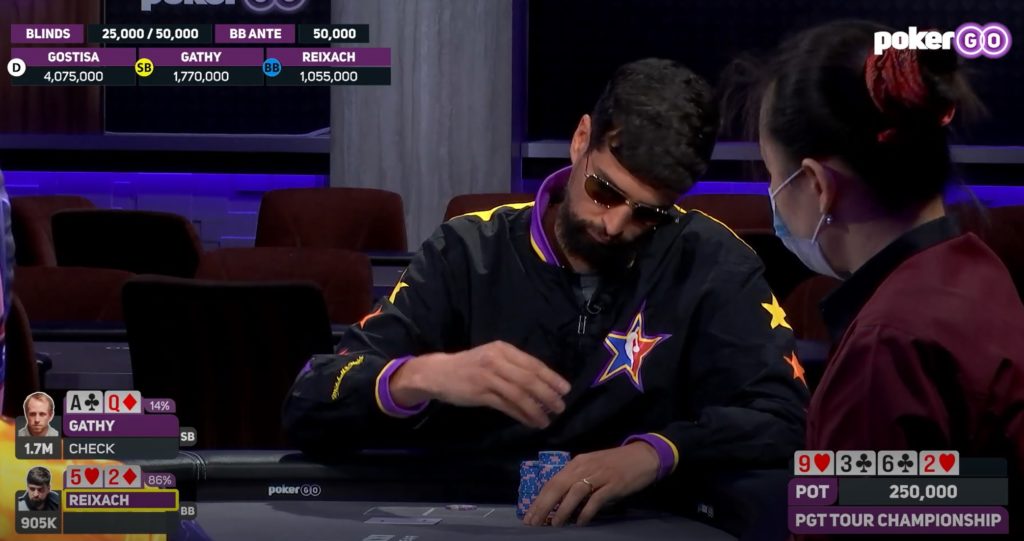You can't win at poker in the long-term without incorporating bluffs into your game. If you're merely playing strong hands, your opponents will figure out your style, and take advantage of your predictable play.
With that said, bluffing is risky. You're building the pot with an inferior hand.
By being selective with the hands we elect to bluff with, we can maintain deception, yet moderate the risk.
This is where the crucial weapon, the semi-bluff comes in.
Semi-bluffing takes one of the most dangerous elements of poker and helps you manage the risk whilst providing you with another tool in your arsenal to take down more pots.
Semi-Bluffing = Bluffing With Outs
So what is a semi-bluff? At its core, semi-bluffing is bluffing with outs.
In standard bluffing, you are betting a hand that is neither ahead nor has a realistic chance of improving to be a winner by the showdown.

With semi-bluffing, you are betting a hand that is likely behind presently but has strong odds of improving to become the best hand by the showdown.
For example, if you have 7♠4♦ on a flop of Q♣9♣J♦, then your bet is a pure bluff. You have no chance of winning this hand unless your opposition folds.
However, if you have A♣10♣ with the same flop, you may still be behind with just ace high, but the odds of winning the hand at showdown are dramatically improved.
In this case, you have an open-ended straight draw, a flush draw and an overcard with the ace. You have potentially 18 outs to win.
Note that a semi-bluff requires that you have a reasonable chance to win at showdown. A hand needing running cards (such as a backdoor flush or straight draw) to win is not really considered a semi-bluff in the traditional sense - although these hands are better candidates to bluff with than complete air.
You must have a way to improve to a hand that's a good chance to be a winner for it to be a justifiable semi-bluff.
Thus having 2 ways to win the hand when you bet or raise as a semi-bluff:
Either your opponent folds (fold equity) or you hit one of your outs to take the lead in the hand (pot equity).
By utilizing the right amount of these 2 key elements, you'll be creating some really profitable opportunities at the table and making yourself more difficult to play against.
Making the Best Hand (Pot Equity)
When considering hands to run a semi-bluff with, general categories include;
- Monster drawing hands
- Drawing hands with overcards
- Flush or open-ended straight draws
- Big overcards
Let's look at each type of hand briefly:
Monster Drawing Hands
Monster drawing hands are hands where you're looking at both an open-ended straight draw and a flush draw. The best of these hands also happen to have overcards to the board.
For example, Q♦J♦ on a T♣9♦4♦ board is a perfect example. A slightly better example would be an open-ended straight flush draw: Q♦J♦ on a T♦9♦4♣ due to your slightly higher number of nut cards you can turn or river.
In most situations, this hand will be pushing a lot of equity against your opponents' range. You have an open-ended straight draw, a flush draw and two overcards to the board to improve the strength of your hand.
In this case, you have 21 outs to improve.
Drawing Hands With Overcards
If you have Q♦J♦ on a T♣9♦4♠ board, you have an open-ended straight draw and overcards, or about 14 outs to improve. A draw likely to have good equity against your opponent's hand.
Flush or Open-Ended Straight Draws
Flush or open-ended draws are another great hand because you're sitting with eight or nine outs to improve to a really strong hand.
Big Overcards
Out of the primary groupings, this is the weakest hand to semi-bluff with because you're only looking at six outs to improve. A typical example would be A♦K♦ on a low flop like 8♥6♦2♣. Your ace-high might be behind, but hitting an ace or king will often win you the hand.
Other hand types
Can you semi-bluff with weaker hands? Sure, but you're venturing more into pure bluffing, rather than semi-bluffing. For example, semi-bluffing with a gutshot straight draw only gives you four cards to win. The bigger the draw the better since this will increase our equity in the hand.
But in poker, the ideal spots don't always occur so you have to work with the opportunities you're given. If you have the initiative in the hand and since your opponent may have a weak range, getting aggressive with fewer outs might be a profitable option.
Continuation betting is an example of this and is something we cover in our tournament poker tips article. Additionally, HowToPlayPokerInfo has a useful article called Continuation betting: The Ultimate Guide.
Often you'll be continuing to represent a strong hand on the flop after raising preflop and you may just be holding a couple of overcards. Just be sure to know the math so you can make better decisions, including being able to quickly calculate your likely outs in the hand.
Outs and Pot Equity
So we know outs are the cards you can hit to make the best hand. But not all outs will always be 'clean', sometimes your opponent may hold a bigger draw. Such as a higher flush draw which taints a lot of your flush outs. Reducing your equity significantly.
Of course, we can't see our opponents' cards so we have to do our best to anticipate the type of hand they may be holding. Be careful playing weaker draws. Refrain from limping in or raising it up with weak hands, stick to PokerNerve's winning hand ranges to play as profitable poker as possible.
Free MTT Poker Training:
The Underused MTT Skills Essential For Success
- 5 Day Email MTT Poker Training Course By Poker Pro Kelvin "Acesup" Beattie
- 3 Key Skills That Will Take Your MTT Poker Game To A New Level
- 1.5 Hours Of Professional Poker Training

Calculating Outs, the 2x4 rule
To quickly approximate your equity, you can simply work out your outs then multiply it by 2 to get a percentage of hitting your hand to the next street. In the case of calculating from the flop to the river, you can multiply by 4.
So with 78 on a flop of 652, where a 4 or 9 will give us the nuts, that's 8 outs x 2 = 16% chance of hitting on the turn, or 8 x 4 = 32% of hitting by the river.
With big draws with over 8 outs, we need to make a slight modification calculating the flop to the river. So with A♦K♦ on 5♦4♦2♣, we figure to have 9 diamonds, 3 threes (1 is a diamond so don't count it twice), 3 aces, and 3 kings to help our hand.
That's 17 outs. 17 x 2 = 34% to hit on the turn. When calculating the flop to the river, however, 17 x 4 tends to overestimate the percentage. So to adjust for this, we remove the number of outs above 8 from the final percentage. So we work it out as 17 x 4 - 9 = 59% (because 17 is 9 above 8 so we subtract 9 from the result).
In the above example, it may also be ambitious to presume all of our outs are clean. For example, if our opponent has 66, then the gutshot outs will give our opponent a higher straight. Or perhaps an opponent has AA reducing our overcard-outs.
To account for this, you can subtract some outs or even halve outs as you see fit. So you might use 1.5 outs instead of 3 for the gutshot and so forth, to avoid always calculating the best-case scenario where none of your outs are tainted or blocked.
This method is especially useful for weaker draws.
The 2x4 rule is used by nearly all pros to quickly calculate equity on the spot. It's an essential skill to master which we cover in detail in our tournament poker course.
But you check out this video on draws and outs to get the basics:
[embedyt] https://www.youtube.com/watch?v=SzuCBWYxPXo[/embedyt]The next element when it comes to successful semi-bluffing isn't so easy to calculate - fold equity.
Fold Equity
When it comes to estimating the chance our opponents fold to our semi-bluff bet or raise, since we're essentially hand reading, many of the skills of poker come into play. Such as the lead-up action in the hand, positions, player styles, stack sizes, stage of play if it's a tournament, if you are heads-up or full ring, and so forth. Quite a lot of considerations to factor in, but here are a few golden rules when it comes to fold equity.
- Is the pot heads-up or multiway? Careful semi-bluffing in multi-way pots with weaker draws. The chance of being dominated combined with reduced fold equity often makes semi-bluffing less attractive in this spot.
- Is your opponent a calling station? Players that don't fold make semi-bluffing, especially with weaker draws, less desirable.
- How capped is your opponents' range? Has your opponent not shown a lot of strength in the hand and their range likely to hold a lot of medium to weaker strength holdings? This could be a good opportunity to semi-bluff and capitalize on the powerful combination of fold equity and pot equity.
For more information on fold equity, see our full article here.
Combining Fold Equity with Pot Equity to Win More Pots
The trick to successful semi-bluffing is to combine strong pot equity with a good chance of your opponent folding. As is demonstrated in this short example.
In the second example shown, we see the other way we can win when semi-bluffing. Acesup hits one of his outs and takes down a nice pot. Using the semi-bluff allowed for some aggressive play, creating some really profitable opportunities. The power of the semi-bluff at work!
Pure Bluffing vs Semi-bluffing
When it comes to pure bluffing, you're relying completely on your opponent to fold for the play to be profitable.
For example, in the video above, if in the first hand Acesup held K6o and not the K♠2♠ which offered both straight and flush possibilities, the play would likely have been a loser.
Using a simple formula we can measure a bluffs success rate required in order for it to be profitable:
breakeven % = risk / (risk + reward)
breakeven % = 3181 / 3181 + 1398.
breakeven % = 3181 / 4579 = 69%
That's quite a high percentage to expect an opponent to fold without a dead accurate read, which will be rare to have.
However, when we factor in our chance of completing a flush or straight, which is 24% using the 2x4 calculation (12 outs x 2), the play becomes more viable.
Let's take a look at how to calculate situations like this by doing an expected value calculation. An easy way to do it is to break it down into the possible outcomes. When semi-bluffing, there are 3 possible outcomes in the hand.
- Villain folds
- Villain calls and loses
- Villain calls and wins
So let's estimate that villain folds half of the time in this spot.
Clearly not profitable as a pure bluff since they needed to fold 69% of the time for a pure bluff to make money. But with decent pot equity on our side (24% we calculated) that we will realise 100% of the time because we are all in (see equity realization for more information), let's see the result from semi-bluffing;
- 50% of the time villain folds and we gain 1398 chips (50% x 1398 = 699)
- 50% of the time villain calls. We make a flush 24% of the time and add 4,213 chips to our stack (50% x 24% x 4213 = 505)
- 50% of the time when the villain calls, we miss our draw 76% of the time and lose 3181 chips (50% x 76% x 3181 = 1208)
So we can gain 699+505 = 1204 when things go our way. But lose 1208 chips in the long run when things don't go our way. Totaling out to be basically a break-even proposition (-4 chips).
In the actual hand, if the villain was folding half the time this would actually be a really profitable play since it was a knockout tournament. Busting a player from the tournament results in an instant cash reward.
Just another thing to think about if you are playing a KO or PKO tournament and executing the semi-bluff!
Stack size, SPR and other considerations
In order to maximize the important element of fold equity that makes semi-bluffing so profitable, be sure to leverage your stack effectively.
Monitor the size of the pot and your chips remaining (Stack to pot ratio or SPR) and the action sequence so you have enough chips to put the pressure on your opponent with a bet or raise. If you make an all-in raise that isn't much more for your opponent to call, then you likely could have taken a better line in the hand for a more profitable result.
Ideally being the last aggressor is the way to go, as this video points out.
For those wanting even more information on M and SPR, check out some more of our videos on M and SPR techniques.
A donk-bet semi-bluff almost always only occurs when short-stacked since it's the best way to get leverage. When deeper stacked, other common semi-bluffs include c-betting and barrelling, check-raising the flop or turn, lead betting the turn. Often using some larger size bets and even overbetting can be quite effective since it maximizes on fold equity.
We cover these skills in our free email course which you can check out here: The Underused MTT Skills Essential For Success.
Of course, by the river, we'll either be looking for value when we made our hand or sometimes running a pure bluff. Pure bluffing is inevitably part of a good strategy too but should be used more sparingly.
Whether it be pure bluffing or semi-bluffing, remember the action you take needs to always make sense.
That is, you want to be able to credibly represent a hand. This typically means either having the initiative which is indicative of having an uncapped range and/or alternatively, representing cards that fit a lot better with your range than your opponents.
Here's a video with a couple more final considerations discussed and another example of the semi-bluff at work.
Final Thoughts
In poker it's good to mix up your play so you aren't predictable, so you'll want to be using a strategy where you're sometimes bluffing. While it's exciting to make the successful "stone-cold bluff", it is also extremely risky. Betting with complete air relies purely on your opponent folding.
In many cases, it will be hard to have enough fold equity to make a pure bluff profitable. And so to make the times you do bluff as profitable as possible, try to also have some chance of making the best hand.
By combining fold equity with pot equity, you can generate some really profitable semi-bluffing situations since you have 2 way to win the pot. Your opponent might fold, or you could make the best hand.
Monster draws, which typically contain straight and flush possibilities are great to semi-bluff with since they have a lot of outs and will therefore usually be pushing a lot of equity. You can calculate your equity quickly using the 2x4 rule. Just be sure to account for how clean your outs are.
Weaker draws may sometimes be dominated so aggressive action isn't always the best route to take. Moreover, multi-way pots and confrontations against calling stations are also times when to refrain from investing heavily in the hand with just a draw. Since your fold equity will likely be diminished, often you'll just be relying on hitting one of your outs.
When you anticipate an opponents' range to be capped, that could be a good time to put the pressure on with some large bets.
Especially if your story is convincing that you may be holding a very strong hand. Just be sure to leverage your stack size effectively to generate good fold equity. With a good mix of fold equity and pot equity, the powerful semi-bluff will be netting you considerable gains in the long run.
To master semi-bluffing, as well as learn other key skills to help you crush tournaments, be sure to check out our Road to Success MTT course. If you are not ready for paid content yet, check out other content in TopPokerValue's Free Poker lesson list.




